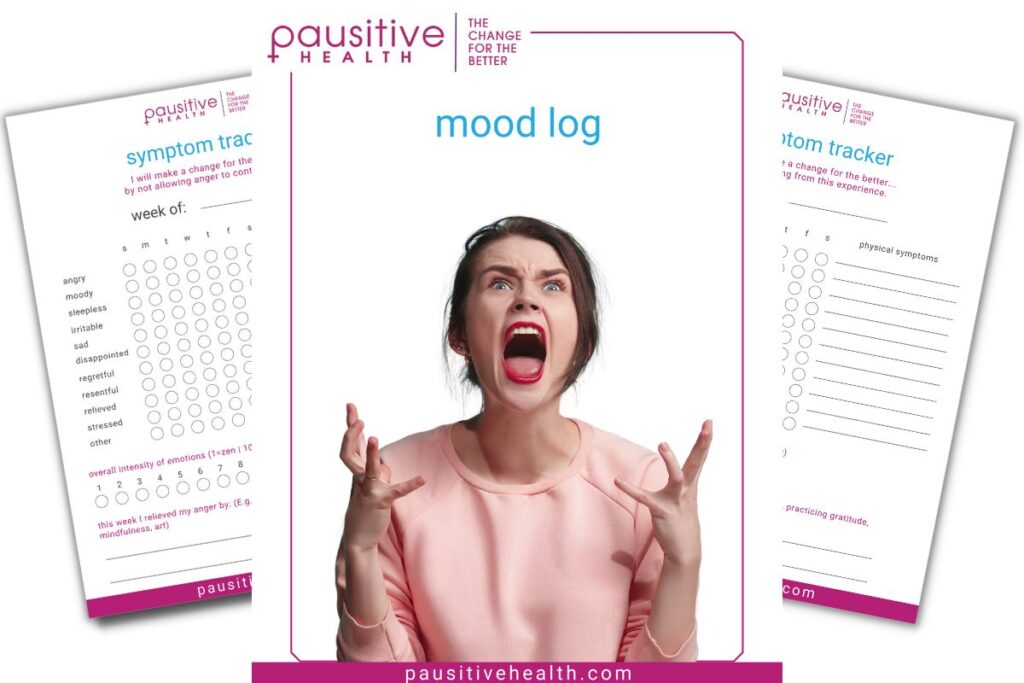Do you feel like you’re ready to roar at any moment? These feelings of rage are common during the menopause transition. If you’re struggling to control your emotions and having angry outbursts, you are not alone. The feelings can be overwhelming, sudden, and long-lasting. If you’re ready to explode at a moment’s notice, harness the power of that anger to tame the force inside you.
Menopausal rage
Most women understand that mood swings are common menopause symptoms, but what about rage? We’re not talking about irritability or anger but the full-on rage that’s hard to control.
The intensity of the emotions, volatility, and suddenness can alarm you and others.
It may leave you looking at yourself in the mirror, wondering who you’ve become.
You may direct the rage at family members, coworkers, friends, or nobody at all.
It may not take much to set you off. Something that in the past would have been a mere nuisance or source of frustration may now serve as a tipping point that leads to a massive overreaction during the menopause transition.
Menopause is like a second adolescence in many ways, as many symptoms mimic those of your teenage years. If you have children, you likely remember toddler tantrums during the “terrible twos.” The tantrums came on suddenly and ended as abruptly as they started.
During menopause, adult tantrums may come and go as quickly as a toddler, last much longer, or settle into a state of chronic simmering anger that is ready to boil over at any moment.
They can leave you scratching your head, too, wondering why your emotions are so strong and how to control them.
These fits of rage can lead you to feel embarrassed, guilty, or shocked by your behavior, for which you seemingly have no control. They can also negatively impact your relationships not only at home but also at work and lead to career repercussions, job insecurity, a low rating on your performance reviews, or conversations with Human Resources.
Family members may think you’ve lost it!
Know that you are not alone! It’s a common concern among midlife women, and there are ways to control the beast.
In the pausitive health survey of women, ten percent mentioned they suffered from anger or rage.
Another 28% reported low mood (13%) or depression (15%).
A post-menopausal woman said, “It’s been awful, and the mood swings and rage are the worst.”
Health impacts of rage
Over time, rage can impact your health, self-confidence, and relationships.
The rage may come and go or be mixed in with other moods making you feel like you’re riding an emotional rollercoaster.
Rage is a form of anger, and it can have the same devastating effects. Over time, anger affects your health, increasing your risk of heart disease, stroke, and respiratory and lung problems, and it also lowers your immune system and life span.
"Holding on to anger is like grasping a hot coal with the intent of throwing it at someone else; you are the one who gets burned."
Buddha
When you go into a fit of rage, your body goes into its flight-or-fight response. Your heart rate increases, your face may turn red, your blood pressure rises, and you do something to release it. Whether that’s yell, scream, or storm off.
In addition, it can lead to other mental health issues like depression. The hormonal transition may already increase the risk of depression in some people, so if you’re experiencing rage, the two may be related.
How to manage your emotions
If you barely recognize yourself in the mirror and are embarrassed by your behavior when directed at others, find a constructive way to manage your emotions. Bottling them up inside isn’t the answer, so you need to find a way to harness that energy and let it go!
You need an outlet for your emotions, which result from hormone fluctuations and may stick around throughout the menopause transition.
There are many non-hormonal treatment options, including movement, physical balance activities, and mind-body relaxation techniques to improve your mood and reduce feelings of rage and anger.
Physical activity
Consider “how” you release the emotions. Can you redirect these emotions toward something else? Can you go for a run, walk, or listen to music?
Exercise has an anti-depressant effect on the body and is used as a behavioral intervention for depressed individuals.
Studies show walking, interval training, and resistance-training have proven effective. When choosing an activity, the aerobic activity level may not make much of a difference. In a study of 40 depressed women, both weightlifting and running similarly reduced depression.
Another study also showed similar results for those who jogged or briskly walked vs. non-aerobic exercises like strength training, relaxation, coordination, and flexibility training.
In a study of 60 participants comparing rowing and combat exercises, only the rowing exercises led to a significant reduction in aggressive feelings.
If you can’t get outside and experience nature, which can also set your mind at ease, treadmill running has also been effective in decreasing anger. In a study of 30 participants, they ran on a treadmill with a dynamic or static image of nature or a self-selected image. While participants ran farther and had higher heart rates when they chose the environmental photo, all participants experienced lower anger, dejection, and anxiety.
Participants experienced happiness only in the nature-based environmental images.
Everyone’s body may react differently to exercise. For example, you may distract your mind and calm down with a high-impact exercise like kickboxing, tennis, or running. Or a mind-body exercise may be a better choice.
Deep breathing
You can also let the rage go with mind-body exercises, both in the moment and over time.
Have you ever tried deep breathing? As you feel yourself accelerating to an emotional explosion, take a step back and take a slow, deep breath. Guide yourself through a series of slow, deliberate deep breaths.
Inhale and expand your abdomen and then exhale while allowing your stomach to fall. Repeat this pattern until the overwhelm passes over you.

Guided imagery
You can also close your eyes and guide your mind to a calmer place like the ocean or mountains. Engage your five senses in this exercise of guided imagery to take your mind and body to a place of calm. Visualize the beach. Hear the sound of waves crashing on the shore. Feel the sand and water flowing over your toes. Smell the saltwater.
If you’re guiding yourself to the mountains, hear the sound of water splashing over rocks. Think about the birds flying overhead and the crisp mountain air. Visualize the mountains flowing into the water and embrace the beauty of the peaks and valleys.
Replay those images in your mind until you’re calm. What’s your place of calm? Perhaps it’s the forest or just sitting in a quiet room. Think about that place, take your mind and body there, and notice the slowed beating of your heart, slowed breathing, and relaxed shoulders.
Practice this guided imagery exercise when you’re calm, so you can train your body to react when the rage builds inside you.
Yoga nidra
Yoga nidra means “yogic sleep,” but you’re not sleeping during this mind-body exercise. You are lying down.
Yoga nidra sets your mind at ease and allows you to enter a state of relaxation.
In veterans suffering from post-traumatic stress disorder (PTSD), yoga nidra reduced rage, anxiety, and emotional reactivity. The veterans felt more relaxed, at peace, and self-aware.
Tapping
Tapping or the Emotional Freedom Technique (EFT), can provide benefits including releasing emotions, like rage.
Julie Schiffman explains how to let go of pent up anger with tapping.
Abiola Abrams, who helps women reclaim their power, also has a tapping exercise for rage. While not specific to menopause, she’s focused on helping women find their calling and power. She says “I have a right to my rage,” as she taps.
You can also try a guided tapping experience.
Progressive muscle relaxation
Tense or knotted muscles are a sign of stress, and you can relax them with progressive muscle relaxation.
It’s a targeted exercise where you guide your mind and body to a state of relaxation, one part of your body at a time. Try this when you feel rage or can’t sleep, another menopause symptom.
It’s best to do this sitting down or lying down.
Start with your toes. Curl them up and tense them. How does that feel?
Recognize that feeling. Then, slowly relax your toes and notice the difference.
Slow and deepen your breathing as you go.
Then, move to your whole foot. Then your legs and so on. Work your way up your body.
Once you’ve hit every area of your body, tense your entire body!
Doing this shifts your focus away from the rage and puts you in tune with how your body feels and reacts to the anger.
It helps relax the muscles, one by one, to decrease your fight-or-flight status.
Progressive muscle relaxation can also help you sleep better. Once again, it shifts your mind from the inability to sleep and the endless sheep that you’ve counted and gets it back into a relaxing state.
Music
Music also has the power to transform your mind and rage. Just by listening to a 3-minute feel good song, you can boost your mood for 45 minutes.
Depending on your mood, you may choose different types of songs. Just because you’re angry or full of rage, doesn’t mean you can’t listen to songs with a similar tone. The University of Queensland (Australia) found listening to heavy metal can help an angry person feel more inspired, calm, and positive.
That may not do the trick for everyone. You may prefer more upbeat tunes or soothing sounds.
Tracking your rage so you can prevent it
Once you triage the immediate issue and let the rage pass, consider coping mechanisms to prevent fits of rage when your anger hits extreme levels.
Ready to tame the beast?
First, identify what’s causing your anger.
That may be difficult to do in the moment. But, after you lose it, take a moment to reflect on the situation.
Look beyond the immediate moment that sparked the rage. That was likely just the breaking point, where you could no longer manage everything else you’re dealing with in life.
Is it stress? Overwhelm? Anger about a situation? Or is it the physical and emotional changes you’re experiencing during menopause? Do you have trauma in your past that you’ve been suppressing but can not contain any longer? Is your anger actually a manifestation of deep depression?
Perhaps you’re feeling this way because you’re sleeping less. If this is the case, make sleep a priority.
Knowing the trigger can help you better manage it.
Use this mood log to track your triggers over a few weeks. Are there patterns?

Get Relief From Your Emotions
Having mood swings? Track how you feel, identify your triggers, and find ways to calm the emotional firestorm with this mood log.
"*" indicates required fields
Recognize what’s causing the anger and overwhelm. Do so without judgment. Remind yourself that it’s normal and you are not alone. Lose all judgment!
If stress precedes the rage, try these self-care strategies that focus heavily on stress management. Incorporate them into your daily routine to lower the overwhelm.
Tap into the aforementioned guided imagery, progressive muscle relaxation, and deep breathing exercises. Also, take a walk outside or find time alone.
Take your stress management techniques to the next level with this guided book, Be Less Stressed. The guidebook is a path toward improved emotional well-being.
Get Professional Help
Call 9-8-8 if you are emotionally distressed (or know someone who is) and need crisis support. You can connect with a trained counselor for free.
Talk to your doctor about options. If the rage is menopause-related, hormone replacement therapy may be an option to help reduce the hormonal volatility.

Find the power in anger
Anger is powerful and often framed in a negative light. However, it can be transformative in a positive way. The same can hold true for rage, an extreme form of anger.
It can catapult you into an unavoidable moment of fixing triggers you never knew existed or had long ignored.
You’re forced to observe what’s going on around you without judgment. Acknowledge the overwhelm, stress, and menopause symptoms. They’re all possible to manage with time and patience. Even menopause! You can control it, so it doesn’t control you.
Recognize that there are reasons you feel rage.
You’re experiencing a stage in life that impacts you physically, mentally, and emotionally.
Don’t think of yourself as a roaring lion. You’re a raging river of water cascading out of the mountains and racing past a meadow. Suddenly that scary moment became positive by changing your mindset about it.
Harness the power of that rage. Become self-aware of your emotions and actions.
Some of the most significant changes in American history came from moments of anger and frustration. Often, these involved women+. This energy may just bewhat you need to channel your passion into causes that have meaning for you, including the state of inequity that exists around the healthcare of women+.
Channel your energies into finding your voice. More women are speaking up about menopause than ever before, and there’s more investment in the natural life cycle of women.
As more people speak up about the impact of menopause and talk about how they feel, rage and all, the more this stage of life will be recognized as one that deserves support, just like other periods in the life cycle.
As a society, we’ll begin to recognize the beauty of menopause. We’ll view it for what it is – yet another amazing life transition in a woman’s life, worthy of attention and understanding.

Free Support
For Your Menopause Journey!
Only available for a limited time!
Access a one-stop menopause journey digital destination that provides personalized text messages that focus on educational topics you select and offers many other features such as a diet assessment with recommendations, solutions from collaboration partners to address menopausal aches and pains (the musculoskeletal syndrome of menopause – MSM), pelvic floor issues, virtual care, lifestyle tools, and a supportive community.
Craft LL, Perna FM. The Benefits of Exercise for the Clinically Depressed. Prim Care Companion J Clin Psychiatry. 2004;6(3):104-111. doi: 10.4088/pcc.v06n0301. PMID: 15361924; PMCID: PMC474733.
Doyne EJ, Ossip-Klein DJ, Bowman ED, Osborn KM, McDougall-Wilson IB, Neimeyer RA. Running versus weight lifting in the treatment of depression. J Consult Clin Psychol. 1987 Oct;55(5):748-54. doi: 10.1037//0022-006x.55.5.748. PMID: 3454786.
Martinsen EW, Hoffart A, Solberg O. Comparing aerobic with nonaerobic forms of exercise in the treatment of clinical depression: a randomized trial. Compr Psychiatry. 1989 Jul-Aug;30(4):324-31. doi: 10.1016/0010-440x(89)90057-6. PMID: 2667882.
Pels, F., & Kleinert, J. (2016). Does Exercise Reduce Aggressive Feelings? An Experiment Examining the Influence of Movement Type and Social Task Conditions on Testiness and Anger Reduction. Perceptual and Motor Skills, 122(3), 971–987. https://doi.org/10.1177/0031512516647802
Yeh H-P, Stone JA, Churchill SM, Brymer E, Davids K. Physical and Emotional Benefits of Different Exercise Environments Designed for Treadmill Running. International Journal of Environmental Research and Public Health. 2017; 14(7):752. https://doi.org/10.3390/ijerph14070752
Stankovic L. Transforming trauma: a qualitative feasibility study of integrative restoration (iRest) yoga Nidra on combat-related post-traumatic stress disorder. Int J Yoga Therap. 2011;(21):23-37. PMID: 22398342.
Pent Up Anger! Letting Go: EFT Tapping with Julie Schiffman | Julie Schiffman (YouTube)
I Am Angry! Feeling Sacred RAGE | Abiola Abrams (YouTube)
Guided Tapping App | Tap with Libbie
Sharman L., Dingle G. Extreme metal music and anger processing. Front. Hum. Neurosci. 21 May 2015. Volume 9 – 2015. doi: https://doi.org/10.3389/fnhum.2015.00272
Guided Steps to Being Less Stressed | Amazon
You may also like…

19 Menopause Self-Care Ideas To De-Stress and Improve Symptoms
Menopause self-care can de-stress you and improve symptoms. Take time for you! Learn 19 self-care ideas.

Menopause Exercise Videos To Improve How You Feel
Try these menopause exercise videos to improve how you feel. They can help with weight loss, body strength, and flexibility.

Can the Emotional Freedom Technique (EFT) Or Tapping Help Menopause Symptoms?
Emotional Freedom Techniques (EFT) or tapping are effective stress relief techniques. Tap into this self-help technique (no pun intended) when you’re in a fit of rage, stressed, or experiencing a mood swing or hot flash.

